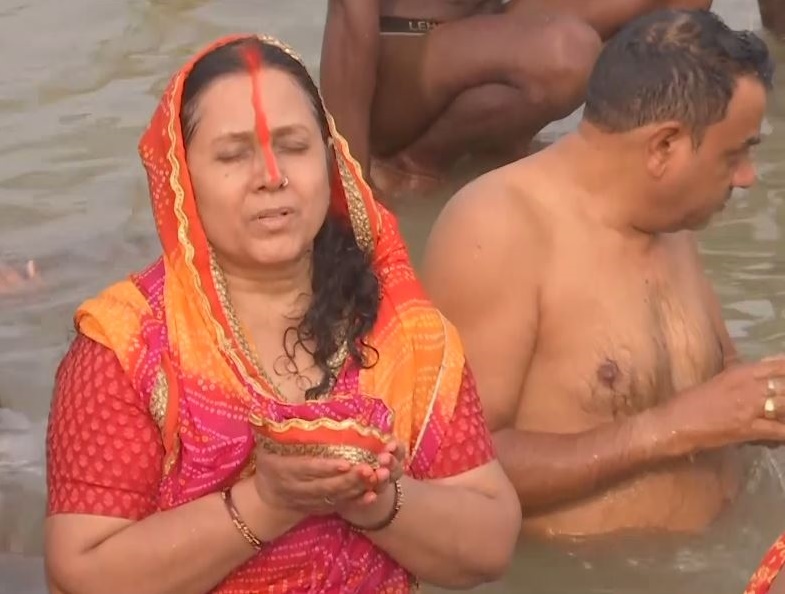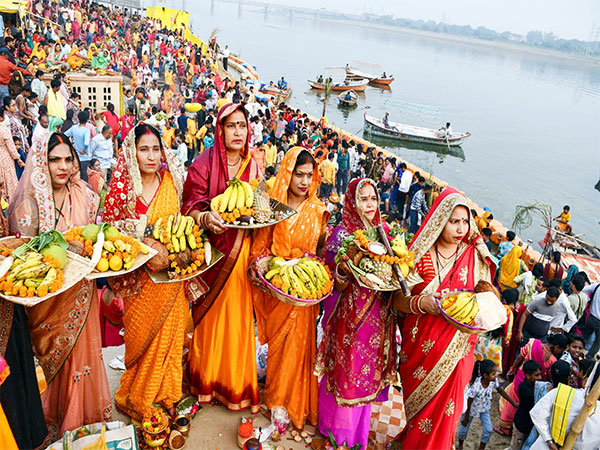|
Chhath Puja 
Chhath puja, the main Hindu festival of Biharis
and Jharkhandis, is celebrated
with traditional fervor to worship the Sun god. It is celebrated on the
sixth day after Deewali, for one night and day. The people of Bihar especially
married women, flock to the banks of river Ganga or to other nearby river
ghats and ponds, to make a ritual offering to Sun god for the prosperity,
happiness and peaceful life of their family members as well as the long
lives of their husbands.
Offerings include cow's milk, coconut and other fruits Some ardent male
devotees crawl the entire route from their house to the river banks bare
chested, as an offering. Devotees observe total fast since sunrise and visit
the river banks in the afternoon to pay homage. More than one lakh people
congregate on the banks of Ganga where prayers are offered in a peaceful
atmosphere. People from other castes also celebrate this festival with equal
importance.
Chhath Puja involves strict rituals and fasting to
express gratitude to the Sun God for sustaining life on Earth. The festival
brings families together to pay homage to Surya Dev (Sun God) and Chhathi
Maiya. Preparations for Chhath Puja starts with Nahaye Khaye, a day which falls
on the Chaturthi Tithi of Kartik Shukla Paksha, is all about cleansing, and
prepping for the festival. Nahay Khay is followed by Kharna
on Panchami Tithi on day 2, Chhath Puja on Sashti, and
concludes with Usha Arghya on Saptami Tithi.
After
taking a holy dip in the ghat and performing puja rituals, people take
sacred 'Ganga Jal' home and prepare prasad. simple food such as ''ghiya
sabzi'' (bottle guard) and ''aloo gobi sabzi'' along with chana dal is
prepared. The next day on Lohanda, when sweet dishes, other foods with rock
salt, rice and paranthas with ghee etc are prepared. On Chhath puja day
women fast for 24 hours. In the evening, puja is performed and after all the
puja rituals and giving ''aradh'' i.e water offering to the Sun god, the
fast is broken.

Again the next day, the fast is broken after giving the
''Argh'' or Arghya to the rising and setting sun. Women hold a ''soop and a
dagar'' to place and offer items to the deity in the festival.
Traditionally made of bamboo, the soop is used to offer items to the deity
during the time of the sun''s worship and dagar is used to place items
like fruits and vegetables. After making this holy offering, parents pray
to Chhatti Maiya for their child''s protection as well as the happiness
and peace of their whole family.
This festival witnesses a high participation rate of women,
is marked with fanfare, and is also regarded as an occasion to take a break
from household chores and be refreshed. It is primarily celebrated in Bihar,
Jharkhand, Uttar Pradesh, and parts of Nepal, as well as by the diaspora
from these regions.
|

